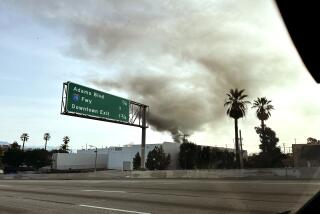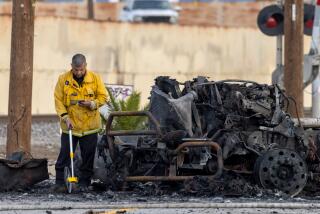Texaco Blast Spotlights Lack of Trauma Centers : Medicine: Injuries from last week’s explosion at the oil refinery were relatively light. But officials worry about future accidents.
When a gigantic boom shattered the night last week, staff members at St. Mary Medical Center in Long Beach ran outside to discover the cause.
They spotted a huge ball of fire billowing on the horizon. Then a call came in on the paramedic radio, warning that 50 people may have been injured in the explosion, which had taken place at Texaco’s Wilmington refinery.
“It was a scary feeling,” said Debbie Kietzer, the emergency-room supervisor who took the call. “It turned out to be unbelievably calm, compared to what it could have been.”
The Long Beach Fire Department coordinated the medical treatment of the explosion victims at the Wilmington refinery, and St. Mary, a trauma center that is relatively close to the refinery, served as the base station for ambulances. The other Long Beach trauma center, Long Beach Memorial Medical Center, along with Pacific Hospital of Long Beach, also treated those injured in the blast.
In the end, fewer than 30 people required treatment for relatively minor injuries in the wake of the Oct. 8 blast. But the accident served as a rude reminder that Los Angeles County’s oil refineries--the familiar towers, pipes and steam plumes punctuating the landscape from the San Diego Freeway southwest to the sea--are capable of producing far graver consequences.
As a result, the explosion has highlighted another problem--a shortage of local hospital facilities capable of gearing up rapidly to handle the scorched skin, seared lungs and internal injuries that a large-scale refinery accident could cause. Of most concern, officials say, is a lack of beds for burn victims.
“We are under-served, to put it mildly, in the case of any large-scale, burn-related tragedy,” said David Langness, vice president of the Hospital Council of Southern California, an association of hospitals in the region.
The South Bay--the area west of Long Beach and north to include Los Angeles International Airport--has nine operating refineries but is equipped with fewer than half a dozen beds for patients with critical burns, all of them at Torrance Memorial Medical Center. Meanwhile, the shrinking network of trauma centers--hospitals that can speedily treat victims of accidents and violence--has left the South Bay with only one full-fledged trauma facility--Harbor-UCLA Medical Center, near Torrance.
In fact, the number of both burn beds and trauma centers in Los Angeles County has dropped sharply over the past five years, in part because hospitals say they cannot afford to offer such costly services.
And the South Bay area, with its oil refineries, chemical plants and Los Angeles International Airport--is particularly vulnerable.
“That area is one of the largest refinery import areas in the world,” Langness said. “There’s probably not an area on the entire West Coast that is as susceptible to burn accidents as those few square miles.”
A spate of recent accidents nationwide has sharpened concern about the safety of oil and petrochemical plants. One of the most widely known is the mammoth explosion that killed 23 workers and injured 130 others in 1989 at the Phillips Co. Houston Chemical Complex in Pasadena, Tex.
In all, more than 100 people have died in oil and petrochemical refineries nationwide in the past seven years.
Although the South Bay has escaped a large-scale disaster, some worry that it could be just a matter of time. Six people have died since 1979 as a result of accidents at the Mobil Oil Corp. plant in Torrance, and as recently as January, 10 construction workers were injured in a steam explosion at the Chevron refinery in El Segundo.
So when the Texaco blast lit up the night sky and rattled windows last week, medical workers braced for scores of injuries.
“It was pretty tense here,” said Kietzer at St. Mary Medical Center, when the call came in at 10 p.m. She contacted other area hospitals and located more than 30 beds for the critically injured and seven beds for burn victims.
But the injuries proved less serious than feared. Only 28 people--16 of them Texaco workers--suffered injuries, most of them minor, hospitals reported this week.
“Everyone expected it to be worse,” said Liz Raganold, trauma coordinator at Long Beach Memorial.
Officials expressed relief that the accident wasn’t more serious.
“In a refinery fire, there could be many, many burn victims, and the county could run out of burn beds,” said Virginia Price-Hastings, county chief of paramedic and trauma programs.
Even without a major disaster, a shortage of beds has sometimes forced area burn victims to be flown out of the county to Fresno, Las Vegas and even San Antonio, Tex.
The county now has a total of about 20 intensive care beds at three burn centers: Torrance Memorial Medical Center, Los Angeles County-USC Medical Center, and Sherman Oaks Hospital and Health Center.
A main reason for the scarcity is that treating serious burns is extremely labor intensive--requiring one nurse or more per patient, officials said.
“Say you’ve got five big burns (treated) one-on-one, that means you have to have 15 nurses” on a 24-hour shift, said Ray Alan Rahn, Torrance Memorial’s executive vice president and chief operating officer.
Brotman Medical Center in Culver City cited the high cost of providing such care when it shut its 23-bed Michael Jackson Burn Center in 1987. Hospital officials said the center had been losing money because of a decline in the number of patients and a drop in government reimbursements for Medicare and Medi-Cal.
Concerns surfaced in 1989 that Torrance Memorial would also close its unit in the face of increasing numbers of patients with little or no insurance. Since then, the unit’s finances have stabilized, Rahn said Thursday. But, he emphasized, Torrance Memorial remains a community hospital, adding that the burn unit’s future could be clouded “if the economics of the burn unit threaten our ability to service the people of the South Bay.”
Treating a burn victim without insurance can cost a hospital a quarter of a million dollars, said Langness of the Hospital Council.
“The thing that’s driven private hospitals out of the burn business is indigent patients,” he said. He would like to see more funding of county burn beds, as well as a statewide arrangement to help care for burn patients in private hospitals.
Medical officials say they are less concerned about the number of trauma centers in the South Bay refinery area. They point out that emergency rooms could gear up to deal with a major accident, much as they did during the Los Angeles riots.
But trauma centers are considered invaluable in the early stages of an accident because beefing up conventional emergency rooms takes time. And financial pressures have prompted a series of hospitals to leave the county trauma system, established in 1983 as a round-the-clock network of emergency rooms specially equipped and staffed to handle serious injuries.
In theory, the network was formed to ensure that patients would be no more than a 20-minute ambulance ride away from the nearest trauma center. Although the system once had 23 participants, the total has dwindled to 13.
The South Bay was directly affected in 1987 when Daniel Freeman Memorial Hospital in Inglewood signed off the network. That left the South Bay with only Harbor-UCLA Medical Center--although the area is also served by a number of regular hospital emergency rooms.
The county still hopes to persuade four hospitals, including Daniel Freeman, to return to the system, Price-Hastings said. Indeed, Daniel Freeman is mentioned repeatedly because it is near Los Angeles International Airport--and therefore a key hospital in the event of a crash there.
The hospital has not entirely ruled out rejoining the trauma system, Administrator Peter Bastone said. But at one point Daniel Freeman was losing $1 million a month on trauma services, he said, pointing out that the question of funding remains a problem.
“If we’re able to cover the cost of doing that service, we’d be happy to talk about it,” Bastone said.
Emergency Care Crunch Experts say the South Bay needs abetter emergency care system because it is home to Los Angeles International Airport, nine oil refining plants and otherfacilites where accidents could cause widespread injuries. Numbered lcoations show refineries, letters designate trauma care and burn facilites. Refineries 1. Chevron, El Sequndo 2. Arco, Carson 3. Mobil, Torrance 4. Texaco, Wilmington 5. Ultramar, Wilmington 6. Fletcher, Carson 7. Huntway, Wilmington 8. Unocal, Carson 9. Unocal, Wilmington Emergency Care Centers A. Long Beach Memorial Medical Center, Long Beach B. St. Mary Medical Center, Long Beach C. Los Angeles County Harbor-UCLA Medical Center D. Los Angeles County-Martin Luther King Jr. / Drew Medical Center, Willowbrook E. Torrance Memorial Medical Center, Torrance
More to Read
Start your day right
Sign up for Essential California for news, features and recommendations from the L.A. Times and beyond in your inbox six days a week.
You may occasionally receive promotional content from the Los Angeles Times.






